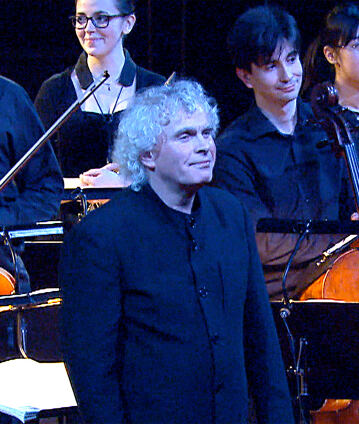“Late Night” concert with Simon Rattle and a new masterpiece

For Simon Rattle, Georg Friedrich Haasʼ in vain is “one of the first masterpieces of the 21st century.” It is mysterious, multiperspectival music that in some way resembles the images of M. C. Escher. The effect is strengthened by the lighting directions given by the composer which create a wide variety of atmospheres. Simon Rattle performs the work with members of the Karajan Academy.
Georg Friedrich Haas set out early on to follow in the footsteps of Ivan Wyschnegradsky and Alois Hábas by grappling with microtonal music. “I became aware early,” says the composer, who was born in Graz in 1953, “that every pitch that the piano offers me, to put it in bold terms, does not constitute the totality of musically reasonable, usable pitches.”
The sensual allure of the varied sound, experimentation with overtone harmonies, and layering of acoustic beats are central moments with which Haas creates his magical worlds of sound – a kind of music about which one can hardly believe it is not produced with electronic instruments. Even the “normally” tempered beginning of his ensemble piece in vain from 2000 is almost imperceptibly overlaid by partial tones, giving rise very gradually to a fascinating counter-world to the uniform semi-tones of the usual tempered tuning system.
For the members of the Karajan Academy of the Berliner Philharmoniker who are being led to unfamiliar territory, performing the work amounts to a special challenge. But the audience too can no longer refer to familiar listening coordinates – particularly because Haas repeatedly creates fluctuating sound spirals which mislead you tonally. The result is music from many perspectives that in some sense resembles the images of M. C. Escher – one has only to think of those staircases where the upper and the lower ends are connected to each other.
© 2013 Berlin Phil Media GmbH
Related interviews
Category
Artists
Our recommendations
- “Late Night” concert with Simon Rattle and Martin Löhr
- “Late Night” concert with Simon Rattle and Magdalena Kožená
- Schubert’s “Winterreise” with Christian Elsner and Simon Rattle
- “Late Night” concert with Simon Rattle and Barbara Hannigan
- “Late Night” concert with Simon Rattle and Stefan Dohr
- Simon Rattle conducts Henze’s Requiem